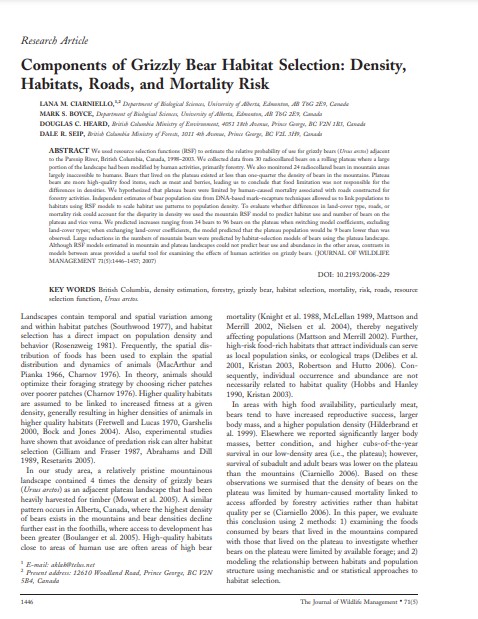Components of Grizzly Bear Habitat Selection: Density, Habitats, Roads and Mortality Risk
Bosque Modelo:
McGregor
Temática:
Conservación
Tipo de documento:
Artículo científico
Resumen
We used resource selection functions (RSF) to estimate the relative probability of use for grizzly bears (Ursus arctos) adjacent to the Parsnip River, British Columbia, Canada, 1998–2003. We collected data from 30 radiocollared bears on a rolling plateau where a large portion of the landscape had been modified by human activities, primarily forestry. We also monitored 24 radiocollared bears in mountain areas largely inaccessible to humans. Bears that lived on the plateau existed at less than one-quarter the density of bears in the mountains. Plateau bears ate more high-quality food items, such as meat and berries, leading us to conclude that food limitation was not responsible for the differences in densities. We hypothesized that plateau bears were limited by human-caused mortality associated with roads constructed for forestry activities. Independent estimates of bear population size from DNA-based mark–recapture techniques allowed us to link populations to habitats using RSF models to scale habitat use patterns to population density. To evaluate whether differences in land-cover type, roads, or mortality risk could account for the disparity in density we used the mountain RSF model to predict habitat use and number of bears on the plateau and vice versa. We predicted increases ranging from 34 bears to 96 bears on the plateau when switching model coefficients, excluding land-cover types; when exchanging land-cover coefficients, the model predicted that the plateau population would be 9 bears lower than was observed. Large reductions in the numbers of mountain bears were predicted by habitat-selection models of bears using the plateau landscape. Although RSF models estimated in mountain and plateau landscapes could not predict bear use and abundance in the other areas, contrasts in models between areas provided a useful tool for examining the effects of human activities on grizzly bears.
Información Bibliográfica
Autor:
Ciarniello, LM, MS Boyce, D Heard and D Seip.
Revista:
Journal of Wildlife Management
Año:
2007
N°:
5
País :
Canadá
Páginas:
1446 - 1457
Volumen:
71
Idioma:
Ingles
Palabras claves
British Columbia, density estimation, forestry, grizzly bear, habitat selection, mortality, risk, roads, resource selection function, Ursus arctos.





